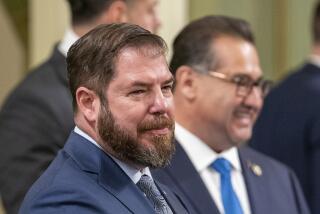Living Without Dental Care
- Share via
Maria Garcia leaned back in the dentist chair feeling none of the fear so common among dental patients. She wasn’t worried about the drill, or the anesthetic, or the metal scraping tools.
“Not nervous,” she said. “So happy.”
Why? For a year, the 59-year-old immigrant from El Salvador has suffered from bleeding gums and pain in her molars so bad that she learned to chew with only her front teeth.
Like most dental patients at the Free Oscar Romero Clinic in Los Angeles, which serves a Latino immigrant population, Garcia--who does not have dental insurance and does not speak English--waited until she couldn’t stand the pain to get treatment.
Her case illustrates what experts call a little-known public health problem of massive proportions in California: poor oral health, particularly among low-income residents, immigrants and minorities.
“Many of our patients have cavities in every single tooth,” said Ana Torres, dental supervisor at the clinic. “They’re adults, but most have never been to a dentist.”
A report released last year by UC San Francisco found that language and cultural barriers, a lack of fluoridated water and a shortage of dentists in low-income communities have intensified the epidemic.
“You have financial barriers, cultural barriers and basic geographical access barriers,” said Beth Mertz, lead researcher for the report. “It’s bordering on a public health care crisis.”
Oral health problems include tooth decay, gum disease and even cancer, said Dr. Tim Collins, dental director of the Los Angeles County Department of Health Services.
People suffering from mouth pain cannot chew food properly and may develop digestive problems, he said. When left untreated, such problems can lead to more serious health issues.
Nationwide, 40% of federally supported community and migrant health centers have dental facilities, according to the Center for Health Care Professionals report. In California, only 25% of community health clinics offer dental care.
“There’s a real shortage of dentists who will see underserved patients,” Mertz said. “When there’s just enough dentists to take care of people who are willing to pay, that doesn’t leave a lot left over for the rest.”
In addition, dental care often becomes a second priority for low-income families, said Lia Margolis, executive director for the Latino Coalition for Healthy California.
“The services that are being provided have long waiting times to get in or co-pays that are difficult for the patients to match or provide,” she said. “Do you put food on the table? Do you pay the rent? Do you take care of grandma’s medicine? Or do you address a toothache?”
The staff at Free Oscar Romero Clinic--where about 90% of patients are immigrants, 90% are Spanish-speaking and 95% have never seen a dentist before--has felt the demand for service, Torres said.
Four dentists serve nearly 325 patients a month. Patients line up in front of the clinic at 4 or 5 a.m. to try to get on the walk-in dental care list, which offers only three slots a day, Torres said.
The average wait for an appointment is two to three months, she said. “So for cases where patients are really in a lot of pain, the best chance is to try to come as early as possible and take a number.”
Although the clinic encourages donations of $5 to $10, “Some patients don’t have even $1 to give,” Torres said. “But that’s OK; we’ll see them. Most of our patients make minimum wage. They have families of four or five, or they are single mothers. So paying even $5 to $10 is really stretching their money out.”
Sometimes people who are desperate go to unlicensed dentists who set up illegal services in their homes or stores, Margolis said.
“It’s a problem, and we know it exists,” she said. “It’s illegal, and the person who is using that service may have no recourse [if something goes wrong], because they are knowingly using a practitioner that is not licensed.”
An average of 70 cases of unlicensed dentists are reported in Los Angeles County each year, said Jeffery Wall, chief investigator of the Dental Board of California. In every case, he said, “people who go to unlicensed dentists are people who are uninsured.”
Seeking treatment from someone who is not licensed is dangerous, Wall said, because the caregiver may not sterilize equipment or wear gloves or masks.
Another concern is the underrepresentation of minorities and bilingual speakers in dentistry. “Access in a language other than what people can understand limits the quality of care,” Margolis said.
If patients do not speak English and the clinic does not have bilingual services, mistakes may be made, she said. They may not understand how to schedule an appointment or explain their symptoms.
Educating people about oral health is also important in preventing “baby-bottle tooth decay,” Mertz said. The risk for the disorder is particularly high among low-income and minority groups, according to Mertz’s study.
The disorder, which causes severe tooth decay in infants, occurs when parents allow their children to drink sugar-filled liquids, including milk, for excessive periods of time, Collins said.
Some people give their children sugar water but do not know it is damaging to teeth, Mertz said.
Everyone should see a dentist at least twice a year, Collins said. But the most important way to prevent oral health problems is to brush and floss regularly. Prevention begins at home, he said, and that is why the need to educate all populations--particularly those who may not speak the language or understand the need--is so important.
More to Read
Sign up for Essential California
The most important California stories and recommendations in your inbox every morning.
You may occasionally receive promotional content from the Los Angeles Times.













